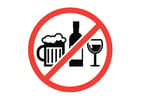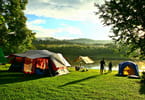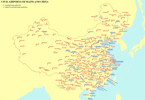Marketing the US Mountain West region, a giant billboard advertising the wonders of Montana sits along Interstate 25 south of Sheridan, Montana, USA.
“Montana: Get Lost,” reads the oversized ad. The Bighorn Mountains, a symbol of Wyoming’s unbounded wilderness, stand a few miles west of the display.
The billboard signifies the complicated relationship western states have as they try to lure travelers to their own high peaks, lush valleys and diverse ecosystems. Tourism is the No. 2 industry for both Wyoming and its northern neighbor. In many cases, a tourist who goes to Montana is qualified as lost revenue for Wyoming, said Diane Shober, Wyoming Office of Tourism director.
A report in the Wyoming news says:
In the Mountain West, state governments pour millions into TV, newspaper, digital and outdoor ads in cities such as Chicago, Dallas, Oklahoma City and Portland. The competition between states is like a game of tug of war, with huge payouts for the winners.
Wyoming and Montana are fighting over Yellowstone. Nearly all the park is in Wyoming, but three of its five entrances are in Montana. The location is a boon for the Treasure State. Its gateway communities lure people away from Jackson and Cody and attract them to places such as Gardiner and Billings.
“It’s a battle,” said Katy Peterson, chief of marketing for the Montana Office of Tourism. “At the end of the day we know Yellowstone is the motivating draw to come out here. Travelers drop a lot of money in the communities on the days they’re here.”
The problem for Wyoming is that travelers living outside of the Mountain West don’t always view Yellowstone as a part of Wyoming, Shober said.
“We need a Wyoming and Yellowstone that are linked at the hip,” she said.
It’s a lucrative venture to attract out-of-state tourists looking for the Wild West veneer they see in John Ford films and read about in Zane Grey novels.
For a relatively small government expense, the returns on investment are huge. Montana spends $10 million per year on advertising in national and international markets. Wyoming spends $6.5 million.
In return, Wyoming received $128 million in tax revenue in 2012 and enjoyed $3.1 billion in consumer spending. Montana earned $305 million in revenues and consumers spent $3.3 billion.
With so much money up for grabs, both states are using data-mining to win tourists, just as politicos mine potential voters for an election. They track demographics and use what marketing gurus call psychographics to reach new customers. They use programs including Google Analytics and music sites such as Pandora to track moods, values and behaviors along with age, education and race of potential customers.
“We understand what makes consumers tick,” Peterson said.
Experts in both states attribute the success to government-sponsored ad campaigns.
The Wyoming Office of Tourism wasn’t immune to budget cuts made by state lawmakers last year. The agency’s $12 million budget took a $1 million hit.
Shober is trying to make up for the loss, but in the Cowboy State it’s no easy task convincing frugal lawmakers to shell out general fund dollars for advertising.
In Gov. Matt Mead’s recent biennium budget proposal he included a one-time appropriation of $2.7 million to keep Wyoming’s ad budget at its annual $6.5 million rate. He also added a $1.86 million appropriation for expanding marketing efforts in international and domestic markets.
It’s no guarantee lawmakers will approve the recommendations when the Legislature convenes in February. The state has seen a 51 percent jump in traveler spending and a 20 percent hike in people who stay overnight since Wyoming started paying for advertising in 2004.
“I think the timing is right for Wyoming to make a bigger investment in tourism,” said Sen. Ogden Driskill, R-Devils Tower, a member of the Senate Travel, Recreation, Wildlife and Cultural Resources Committee. “The investment would pay off. But getting it through the Legislature may not be so easy.”
Some question whether the state needs to invest more money in order to set trends rather than follow them. Rep. Allen Jaggi, R-Lyman, member of the House travel committee, wants to see less government spending.
With the uncertainty revolving around coal and sagging natural gas prices, he and a cadre of other fiscal hawks in the Legislature want to stick to the credo that it’s better to save than spend.
The state should pay some of the costs but not bear the brunt, he said.
“We need to advertise,” he said. “It’s a gold mine. We got to let people know what we have. But we are doing a lot of free advertising for every hotel and restaurant in the state. I don’t think the general fund should be doing that.”
Everyone benefits from tourism in Wyoming, he said, but some more than others. The hospitality industry — hotels, restaurants, dude ranches, tour guides — should pick up some of the slack since they are biggest beneficiary. Jaggi would like to see a 50-50 split.
“I don’t think we can do what we used to do,” he said.
As a Gillette native, Shober knows where the brunt of her agency’s budget comes from: energy industry severance taxes.
She doesn’t think tourism can overtake energy as the state’s No. 1 industry. But she believes it can be a supplement if hard times do fall on the state’s natural resource industries.
“In our world they can reside side by side,” she said.
Wyoming’s neighbor to the south is an example of what happens when the state divests its role in promoting tourism.
State lawmakers cut all funding to the Colorado Tourism Office’s ad budget in 1993.
Colorado had a 2.7 percent share of the nationwide tourism market at the time. The state’s share of the national market sank to 1.8 percent one year after the cuts took effect, said Al White, director of the Colorado Office of Tourism.
Lawmakers didn’t begin to re-fund tourism until 2000.
“We didn’t get back to 2.7 percent until 2011,” he said.
White says for every dollar spent on tourism in Colorado the state receives six in return. Wyoming’s neighbor to the south has a $17 million budget annually. Of that, $15 million goes into marketing, White said.
“It’s short-sighted for legislators to cut or defund tourism,” he said.
WHAT TO TAKE AWAY FROM THIS ARTICLE:
- The state has seen a 51 percent jump in traveler spending and a 20 percent hike in people who stay overnight since Wyoming started paying for advertising in 2004.
- Shober is trying to make up for the loss, but in the Cowboy State it's no easy task convincing frugal lawmakers to shell out general fund dollars for advertising.
- It's a lucrative venture to attract out-of-state tourists looking for the Wild West veneer they see in John Ford films and read about in Zane Grey novels.






















